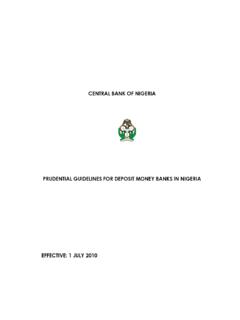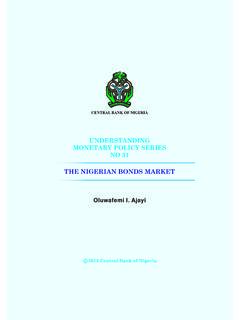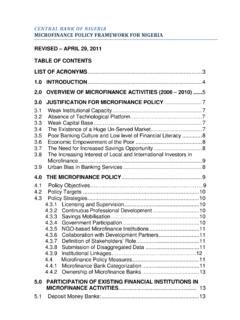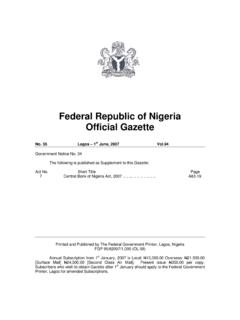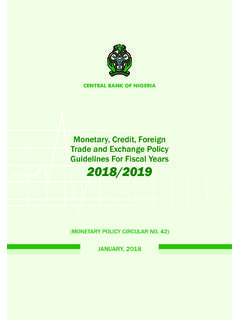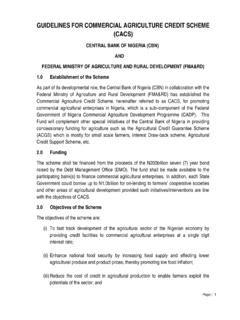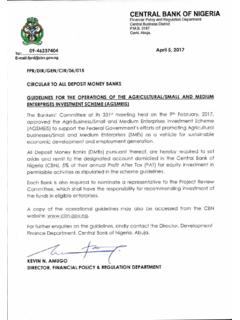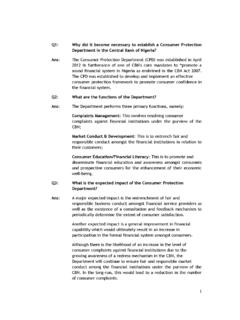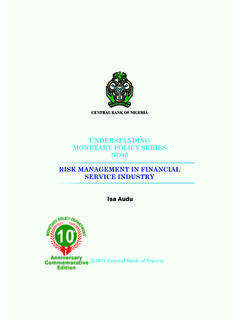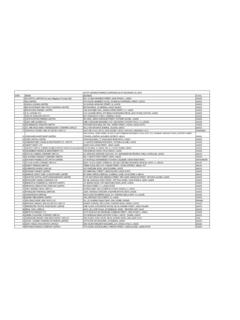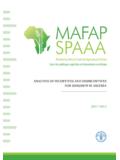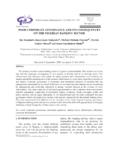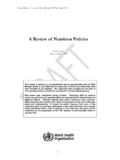Transcription of CENTRAL BANK OF NIGERIA
1 CENTRAL BANK OF NIGERIA VOLUME 5, NUMBER 3, SEPTEMBER 2016 2 E D I T O R I A L COMMITTEE EDITOR-IN-CHIEF Mohammed M. Tumala, PhD Director of Statistics EDITOR Olorunsola E. Olowofeso, PhD Deputy Director MANAGING EDITOR Garba A. Manya Assistant Director ASSOCIATE EDITORS Adeyemi A. Adeboye Valli T. Adejo Senior Statisticians Suleiman F. Ogunyinka Obinna R. Ogbuka Assistant Statisticians This Statistical Bulletin is a publication of the CENTRAL Bank of NIGERIA (CBN). All enquiries, comments and suggestions should be addressed to: The Director, Statistics Department, CENTRAL Bank of NIGERIA , 0187, Garki, Abuja. Data contained in this Bulletin as well as other high frequency data can be accessed online at the CBN Statistics Database on 3 Vision of the CBN Be the model CENTRAL bank delivering price and financial system stability and promoting sustainable economic development Mission of the CBN To be proactive in providing a stable framework for the economic development of NIGERIA , through the effective, efficient and transparent implementation of monetary exchange rate policy and management of the financial sector Mandate of the Statistics Department To collect, analyze and manage data on all sectors of the economy, in order to provide statistical support to the Bank, the government, international organizations and other stakeholders 4 CONTENTS EXPLANATORY NOTES SECTION A FINANCIAL STATISTICS : Monetary Survey (N' Million) : Monetary Survey (N' Million) : Growth Rates of Monetary Aggregates.
2 Growth Rates of Monetary Aggregates : Monetary Authorities' Analytical Accounts - Assets (N' Million) : Monetary Authorities' Analytical Accounts - Assets (N' Million) : Monetary Authorities' Analytical Accounts - Liabilities (N' Million) : Monetary Authorities' Analytical Accounts - Liabilities (N' Million) : Commercial & Non Interest Banks' Statement of Assets (N' Million) : Commercial & Non Interest Banks' Statement of Assets (N' Million) : Commercial & Non Interest Banks' Statement of Liabilities (N' Million) : Commercial & Non Interest Banks' Statement of Liabilities (N' Million) : Merchant Banks' Statement of Assets (N' Million) : Merchant Banks' Statement of Assets (N' Million) : Merchant Banks' Statement of Liabilities (N' Million) : Merchant Banks' Statement of Liabilities (N' Million) : Deposit Money Banks' Sectoral Allocation of Credit (N' Million) 5 : Deposit Money Banks' Loans to SMEs and Rural Customers (N' Million) : Money Market Weighted Average Interest Rates - Unless Otherwise Indicated (Per Cent) : Discount Houses Consolidated Balance Sheet (N' Million) : Stocks Market Statistics Equities Only Microfinance Banks' Consolidated Balance Sheet (N' Million) Primary Mortgage Institutions' (PMIs) Consolidated Balance Sheet (N' Million) Microfinance Banks' Consolidated Balance Sheet (N' Million) : Primary Mortgage Institutions' (PMIs) Consolidated Balance Sheet (N' Million) : Bank of Industry's (BOIs) Consolidated Balance Sheet (N' Million) : The Infrastructure Bank's (TIBs) Consolidated Balance Sheet (N' Million) : Bank of Agriculture (BOA) Consolidated Balance Sheet (N' Million) : NEXIM Bank Consolidated Balance Sheet (N' Million) : Finance Houses Consolidated Balance Sheet (N' Million).
3 Pension Funds Consolidated Balance Sheet (N' Million) : Insurance Sector (General and Life) Consolidated Balance Sheet (N' Million) B GOVERNMENT FINANCE STATISTICS : Summary of Federal Government Collected Revenue (N Billion) : FGN Finances (N Billion) : Federal Government Finances (N Billion) : Local Government Finances (N Billion) : Quarterly Domestic Debt Stock by Holder s (N Billion) 6 : Quarterly Domestic Debt Stock by Maturity (N Billion) : Quarterly Domestic Debt Stock by Instrument (N Billion) : Quarterly Domestic Debt Service by Payment (N Billion) : NIGERIA s Public Debt Stock C REAL SECTOR STATISTICS : Consumer Price Indices and Inflation Rates : Gross Domestic Product at Current Basic Prices (N' Million) : Gross Domestic Product at 2010 Constant Basic Prices (N' Million) : Implicit Price Deflator (Base Year 2010 Series) : Quarterly Gross Domestic Product by Expenditure at Current Purchasers Prices (N Million) : Quarterly Gross Domestic Product and Expenditure at Current Market Prices (N' Million) : Quarterly Gross Domestic Product by Expenditure at 1990 Constant Purchasers Prices (N Million) : Quarterly Gross Domestic Product by Expenditure at 2010 Market Prices (N' Million) : Index of Industrial Production (1990 = 100) : Real Sector Indices (2010 = 100) : Spot Price of NIGERIA 's Reference Crude Petroleum - Bonny Light (US$ per Barrel) : Indices of Average World Prices of NIGERIA 's Major Agricultural Export Commodities for 2008 (Dollar Based) (2010 = 100) : Indices of Average World Prices of NIGERIA 's Major Agricultural Export Commodities for 2008 (Naira Based) (2010 = 100) D EXTERNAL SECTOR STATISTICS : International Trade Summary (US$' Million) 7.
4 Total Exports (US$' Million) : Total Imports - CIF & FOB (US$' Million) : Balance of Payments Compilation (US$' Million) : Balance of Payments Compilation (N' Million) : Balance of Payments Analytic Presentation (US$' Million) D7: Balance of Payments Analytic Presentation (N' Million) : Currency Composition of Foreign Exchange Reserves (COFER) ($' Million) : Commodity Prices : Instrument Composition of Transactions in Foreign Exchange Reserves (US$' Million) : Gross External Reserves (US$' Million) : Exchange Rates of the Naira (N/US$ ) : Nominal and Real Effective Exchange Rates (November 2009 = 100) : Supply of FOREX (US$' Million) : Foreign Exchange Flows Through the Nigerian Economy (US$' Million) : Sectoral Utilization of Foreign Exchange (US$' Million) : External Debt & Debt Service (US$' Million) : All Products (SITC) Terms of Trade (Jan 2007 = 100) 8 EXPLANATORY NOTES SECTION A: FINANCIAL STATISTICS Financial data are normally compiled from balance sheets and financial statements which are primarily designed to meet a variety of legal and administrative requirements, as well as the specific needs of economic analysis.
5 Financial data compilation involves the aggregation of the financial system s accounts to the level at which general macroeconomic tendencies are discernible. The consolidation of the balance sheets of the monetary authorities and the deposit money banks (Tables ) produces the monetary survey. Growth rates of monetary aggregates are presented in Tables and Meanwhile, consolidated accounts of the monetary authorities, which are shown in Tables , , and , are derived from different sub-accounts of the CBN operations. Prior to the re-engineering efforts of the CBN, the end-month summary and detailed analytical balance sheets were generated from consolidation of the head office and branches general ledger balances. Since re-engineering in 2004, the Finance Department prepares the CBN Analytical Balance Sheet (ABS) using data obtained from the Oracle ERP application.
6 This is forwarded to the Statistics Department as an input for monetary survey. The CBN adopted the International Financial Reporting Standards (IFRS) in March 2014 in compliance with international best practice. The Financial Analysis (FinA), which replaced the electronic Financial Analysis Surveillance System (eFASS) is deployed to facilitate the compliance of deposit money banks returns with the IFRS. Various tables of different deposit money banks are presented in Tables The monthly interest rate returns are used to compute the weighted average lending and deposit rates, using as weights, the loans and advances (net) and total depositors funds, respectively.
7 The deposit rates: savings and time/term deposit of various maturities ranging from 3 months to over 12 months are so generated; lending rates and other money market interest rates are captured on Tables The consolidated balance sheets of microfinance banks, primary mortgage institutions, finance houses, pension funds and insurance sector as well as those of development institutions are found in Tables , Table is on capital market statistics. SECTION B: GOVERNMENT FINANCE STATISTICS The fiscal sector indicators are the revenue, expenditure, and public debts (domestic and external) of the Federal, State and Local Governments. Revenue is an inflow of resources or money into the government sector from other economic units/sectors. It includes all non-repayable receipts and grants and is divided into current and capital. 9 While current revenue comprises tax and non-tax receipts within a given period, capital revenue are receipts from non-financial assets used in production process for more than one year.
8 Grants are non-compulsory, non-repayable unrequited receipts from other governments and international institutions. Expenditure is an outflow of resources from government to other sectors of the economy whether requited or unrequited. It is divided into recurrent and capital expenditures. While recurrent expenditures are payments for salaries and overheads, capital expenditures are payments for non-financial assets. The difference between government payments for expenditure and total receipts from revenue could either be surplus or deficit. If revenue is greater than expenditure, there is a surplus, but when expenditure is greater than revenue, we have a deficit. Financing represents government s sources of meeting deficit or utilizing surplus. Sources of financing are divided into domestic and foreign. Debt (domestic and external) is a stock of liabilities with different tenors accumulated by government operations in the past and scheduled to be fully repaid by government in the future.
9 It covers only recognized direct financial obligations of government on which government pays interest on redemption. External debt figures in the tables are converted to Naira using annual average exchange rate of the particular year. SECTION C: REAL SECTOR STATISTICS TABLE This table shows monthly consumer price indices and inflation rates given in four forms: - all items (headline), all items less farm produce (core), all items less farm produce & energy (another type of core) and food. The inflation rate is designed to measure the rate of increase of a price index. It is a percentage rate of change in price level over time. The first CPIs were computed separately for the then Federal and Regional Capitals. The indices for Lagos, and Ibadan, Kaduna, Enugu had 1953 and 1957 as base years, respectively. The CBN in collaboration with Federal Office of Statistics (FOS) now National Bureau of Statistics (NBS), felt that the separate indices had some disadvantages.
10 The Consumer Expenditure Survey (CES) conducted in 1957 was reviewed to reflect the need for a single national CPI based on the prices of a union market basket of commodities purchased and consumed by a representatives set of households in selected centres from all over the country, especially since the indices from one centre to another made comparability difficult. A more serious limitation of the index then, was the absence of a composite consumer price index to measure average change in the price of goods and services purchased by the specified groups of consumers. As a result of this limitation, a common base was derived for all-cities index by averaging prices in 1960. In selecting every consumer item, the prices index for any given period was adjusted on the basis that the average price index for the same item in 1960 is 100.
